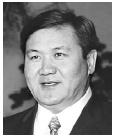MONGOLIA
Nambaryn Enkhbayar
Prime Minister

(pronounced "Nam-bar-EEN en-kah-bye-YAHR")
"The government of Mongolia will press forward democracy and market reforms…This is a duty."
Mongolia is a large landlocked country sandwiched between two larger neighbors, China and Russia. Located at the center of the Asian continent, it covers 1,566,500 sq km (694,100 sq mi). Most of the landscape consists of pasture or desert wasteland, including the famous Gobi desert, known for its extreme daily temperature changes. The Mongolian climate is arid, with surrounding mountains acting as barriers that prevent moist air flow and precipitation. About 10% of the country is forested, supporting an abundance of wildlife—including boar, elk, deer, and bear. Only 1% of the land is arable, and is used to produce wheat, barley, oats, and vegetables.
The sixth-largest country in Asia, Mongolia is sparsely populated, with a population estimated to be 2.7 million or less that two inhabitants per sq km (about four inhabitants per sq mi). Its population was growing at a rate of 1.5% annually as of 2001. About 85% of the people are Mongols (mostly Khalkha), 7% are Turkic, 4.6% Tungusic, and 3.4% other. More than four million Mongolians reside outside their country. The primary religions are Tibetan Buddhist Lamaism (94%) and Muslim (6%), the latter confined to the Turkic population mainly in the southeastern part of the country. Most people speak Khalka Mongolian, the official language. Instead of using the traditional script, however, Mongolians have adopted the Russian Cyrillic alphabet since the Communist revolution. A move to revert back to the Mongolian script was begun in the late 1990s, with Cyrillic to eventually become the second script. Many college-educated Mongolians were trained in the former Soviet Union and are fluent in Russian. The country's literacy rate exceeds 97%. Life expectancy is 62.1 years for males and 66.5 years for females.
Mongolia's per capita gross domestic product (GDP) was estimated at US $1,780 in 2000. The national currency is the togrog (plural tugrik). One-third of the economy revolves around subsistence agriculture and livestock production. Primary exports are copper, minerals, hides, and skins; major imports include petroleum products, industrial equipment, and consumer goods. Significant trading partners are Russia, China, the United States, and Japan.
ADDRESS
Office of the Prime Minister
Ulaanbaator, Mongolia
E-mail: enhbayar@mail.parl.gov.mn
Comment about this article, ask questions, or add new information about this topic: